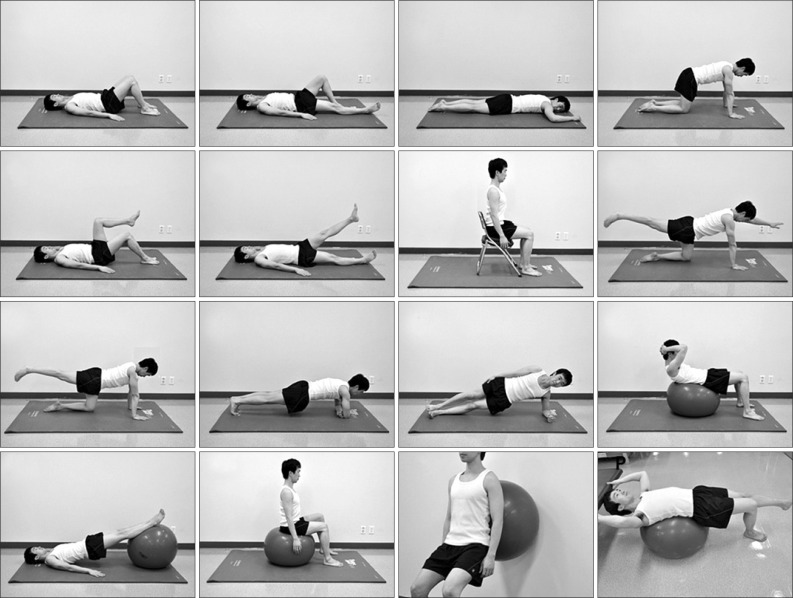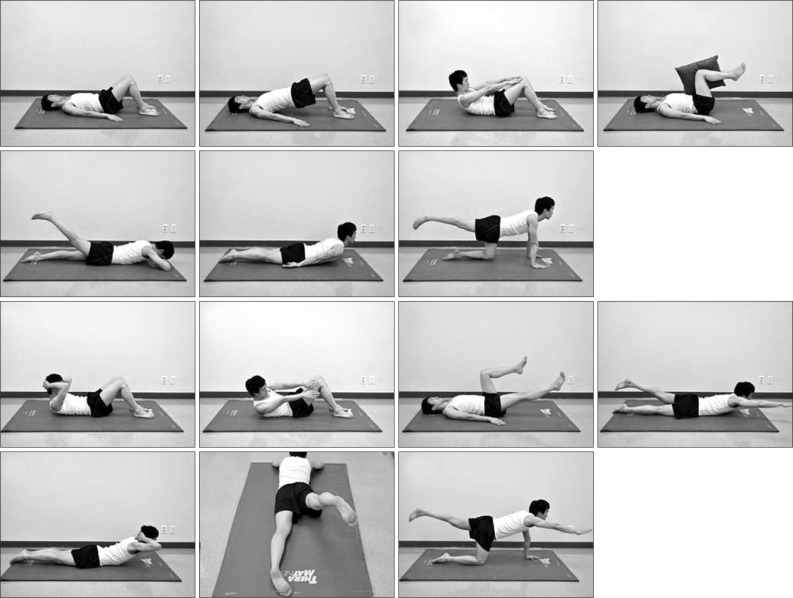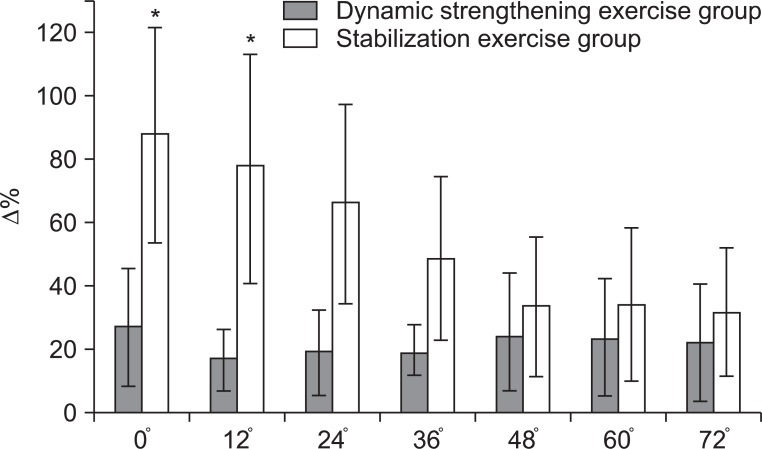Effect of Lumbar Stabilization and Dynamic Lumbar Strengthening Exercises in Patients With Chronic Low Back Pain
- Affiliations
-
- 1Department of Rehabilitation Medicine, Asan Medical Center, University of Ulsan College of Medicine, Seoul, Korea. khchoi@amc.seoul.kr
- KMID: 2266658
- DOI: http://doi.org/10.5535/arm.2013.37.1.110
Abstract
OBJECTIVE
To compare the effects of lumbar stabilization exercises and lumbar dynamic strengthening exercises on the maximal isometric strength of the lumbar extensors, pain severity and functional disability in patients with chronic low back pain (LBP).
METHODS
Patients suffering nonspecific LBP for more than 3 months were included prospectively and randomized into lumbar stabilization exercise group (n=11) or lumbar dynamic strengthening exercise group (n=10). Exercises were performed for 1 hour, twice weekly, for 8 weeks. The strength of the lumbar extensors was measured at various angles ranging from 0degrees to 72degrees at intervals of 12degrees, using a MedX. The visual analog scale (VAS) and the Oswestry Low Back Pain Disability Questionnaire (ODQ) were used to measure the severity of LBP and functional disability before and after the exercise.
RESULTS
Compared with the baseline, lumbar extension strength at all angles improved significantly in both groups after 8 weeks. The improvements were significantly greater in the lumbar stabilization exercise group at 0degrees and 12degrees of lumbar flexion. VAS decreased significantly after treatment; however, the changes were not significantly different between the groups. ODQ scores improved significantly in the stabilization exercise group only.
CONCLUSION
Both lumbar stabilization and dynamic strengthening exercise strengthened the lumbar extensors and reduced LBP. However, the lumbar stabilization exercise was more effective in lumbar extensor strengthening and functional improvement in patients with nonspecific chronic LBP.
MeSH Terms
Figure
Cited by 3 articles
-
Regarding to the Article 'Effect of Lumbar Stabilization and Dynamic Lumbar Strengthening Exercises in Patients With Chronic Low Back Pain'
James Steele
Ann Rehabil Med. 2014;38(6):876-878. doi: 10.5535/arm.2014.38.6.876.Reliability and Validity of a New Method for Isometric Back Extensor Strength Evaluation Using A Hand-Held Dynamometer
Hee-won Park, Sora Baek, Hong Young Kim, Jung-Gyoo Park, Eun Kyoung Kang
Ann Rehabil Med. 2017;41(5):793-800. doi: 10.5535/arm.2017.41.5.793.Effects of Lumbar Strengthening Exercise in Lower-Limb Amputees With Chronic Low Back Pain
Min Kyung Shin, Hee Seung Yang, Hea-Eun Yang, Dae Hyun Kim, Bo Ram Ahn, Hyup Kwon, Ju Hwan Lee, Suk Jung, Hyun Chul Choi, Sun Keaung Yun, Dong Young Ahn, Woo Sob Sim
Ann Rehabil Med. 2018;42(1):59-66. doi: 10.5535/arm.2018.42.1.59.
Reference
-
1. Rozenberg S. Chronic low back pain: definition and treatment. Rev Prat. 2008; 58:265–272. PMID: 18536200.2. Lawrence JP, Greene HS, Grauer JN. Back pain in athletes. J Am Acad Orthop Surg. 2006; 14:726–735. PMID: 17148620.
Article3. Davies JE, Gibson T, Tester L. The value of exercises in the treatment of low back pain. Rheumatol Rehabil. 1979; 18:243–247. PMID: 160072.
Article4. Manniche C, Lundberg E, Christensen I, Bentzen L, Hesselsoe G. Intensive dynamic back exercises for chronic low back pain: a clinical trial. Pain. 1991; 47:53–63. PMID: 1837606.
Article5. McKenzie RA. Prophylaxis in recurrent low back pain. N Z Med J. 1979; 89:22–23. PMID: 155230.6. Plum P, Rehfeld JF. Treatment of acute and chronic back pain with muscular exercises. Ugeskr Laeger. 1985; 147:1604–1611. PMID: 3160150.7. Martin PR, Rose MJ, Nichols PJ, Russell PL, Hughes IG. Physiotherapy exercises for low back pain: process and clinical outcome. Int Rehabil Med. 1986; 8:34–38. PMID: 2942511.
Article8. Mellin G, Jarvikoski A, Verkasalo M. Treatment of patients with chronic low back pain: comparison between rehabilitation centre and outpatient care. Scand J Rehabil Med. 1984; 16:77–84. PMID: 6235577.9. Carpenter DM, Nelson BW. Low back strengthening for the prevention and treatment of low back pain. Med Sci Sports Exerc. 1999; 31:18–24. PMID: 9927005.
Article10. Dettori JR, Bullock SH, Sutlive TG, Franklin RJ, Patience T. The effects of spinal flexion and extension exercises and their associated postures in patients with acute low back pain. Spine (Phila Pa 1976). 1995; 20:2303–2312. PMID: 8553118.11. O'Sullivan PB, Phyty GD, Twomey LT, Allison GT. Evaluation of specific stabilizing exercise in the treatment of chronic low back pain with radiologic diagnosis of spondylolysis or spondylolisthesis. Spine (Phila Pa 1976). 1997; 22:2959–2967. PMID: 9431633.12. Standaert CJ, Weinstein SM, Rumpeltes J. Evidence-informed management of chronic low back pain with lumbar stabilization exercises. Spine J. 2008; 8:114–120. PMID: 18164459.
Article13. Panjabi MM. The stabilizing system of the spine. Part I. Function, dysfunction, adaptation, and enhancement. J Spinal Disord. 1992; 5:383–389. PMID: 1490034.
Article14. Urquhart DM, Hodges PW. Differential activity of regions of transverses abdominis during trunk rotation. Eur Spine J. 2005; 14:393–400. PMID: 15940481.15. Richardson CA, Jull GA. Muscle control-pain control. What exercises would you prescribe? Man Ther. 1995; 1:2–10. PMID: 11327788.
Article16. Robinson ME, Greene AF, O'Connor P, Graves JE, MacMillan M. Reliability of lumbar isometric torque in patients with chronic low back pain. Phys Ther. 1992; 72:186–190. PMID: 1533939.
Article17. Jensen MP, Chen C, Brugger AM. Interpretation of visual analog scale ratings and change scores: a reanalysis of two clinical trials of postoperative pain. J Pain. 2003; 4:407–414. PMID: 14622683.
Article18. Richardson CA, Snijders CJ, Hides JA, Damen L, Pas MS, Storm J. The relation between the transversus abdominis muscles, sacroiliac joint mechanics, and low back pain. Spine (Phila Pa 1976). 2002; 27:399–405. PMID: 11840107.
Article19. Fritz JM, Irrgang JJ. A comparison of a modified Oswestry Low Back Pain Disability Questionnaire and the Quebec Back Pain Disability Scale. Phys Ther. 2001; 81:776–788. PMID: 11175676.
Article20. Hodges PW, Richardson CA. Contraction of the abdominal muscles associated with movement of the lower limb. Phys Ther. 1997; 77:132–142. PMID: 9037214.
Article21. Panjabi M, Abumi K, Duranceau J, Oxland T. Spinal stability and intersegmental muscle forces: a biomechanical model. Spine (Phila Pa 1976). 1989; 14:194–200. PMID: 2922640.22. Graves JE, Pollock ML, Foster D, Leggett SH, Carpenter DM, Vuoso R, et al. Effect of training frequency and specificity on isometric lumbar extension strength. Spine (Phila Pa 1976). 1990; 15:504–509. PMID: 2144914.
Article23. Sanderson PL, Todd BD, Holt GR, Getty CJ. Compensation, work status, and disability in low back pain patients. Spine (Phila Pa 1976). 1995; 20:554–556. PMID: 7604324.
Article24. Ferreira ML, Ferreira PH, Latimer J, Herbert RD, Hodges PW, Jennings MD, et al. Comparison of general exercise, motor control exercise and spinal manipulative therapy for chronic low back pain: a randomized trial. Pain. 2007; 131:31–37. PMID: 17250965.
Article
- Full Text Links
- Actions
-
Cited
- CITED
-
- Close
- Share
- Similar articles
-
- Regarding to the Article 'Effect of Lumbar Stabilization and Dynamic Lumbar Strengthening Exercises in Patients With Chronic Low Back Pain'
- Effect of Lumbar Extensor Strengthening in Chronic Low Back Pain Patients
- Efficacy of Lumbar Segmental Stabilization Exercises and Breathing Exercises on Segmental Stabilization in Lumbar Instability Patients
- The Effect of Back Extensor Strengthening Exercise on Chronic Low Back Pain and Bone Mineral Density
- Comparisons of Spinal Stabilization Exercise and Lumbar Extensor Strengthening Exercise in Chronic Low Back Pain




